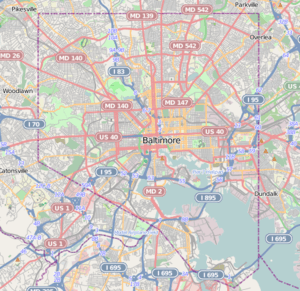Waverly, Baltimore
| Waverly | |
|---|---|
| neighborhood statistical area | |
 Waverly | |
| Coordinates: 39°19′56″N 76°36′24″W / 39.33222°N 76.60667°WCoordinates: 39°19′56″N 76°36′24″W / 39.33222°N 76.60667°W | |
| Country | United States |
| State | Maryland |
| City | Baltimore |
| Area | |
| • Total | .149 sq mi (0.39 km2) |
| • Land | .149 sq mi (0.39 km2) |
| [1] | |
| Population (2010) | |
| • Total | 3,551 |
| • Density | 24,000/sq mi (9,200/km2) |
| [1] | |
| Time zone | Eastern (UTC-5) |
| • Summer (DST) | EDT (UTC-4) |
| ZIP code | 21218 |
| Area code | 410, 443, and 667 |
Waverly is a neighborhood in the Northern District of Baltimore, Maryland, located to the north of the neighborhood of Better Waverly and west of Ednor Gardens-Lakeside. Its boundaries are drawn by Greenmount Avenue on the west, Ellerslie Avenue on the east, East 39th Street to the north and East 33rd Street to the south.[1] The community takes its name from Sir Walter Scott's first novel, Waverly.[2]
Waverly Main Street Historic District, an area listed in the National Register of Historic Places, includes all of the Waverly neighborhood, and the portion of Better Waverly neighborhood located between Greenmount Avenue and Ellerslie Avenue. The Waverly neighborhood is also referred to as "Waverly-north" to distinguish it from the area of the historic district overlapping Better Waverly.[3]
Baltimore's former Memorial Stadium was originally located on the opposite side of Ellerslie Avenue from Waverly, until the structure was demolished on February 15, 2002.[4]
History
The area currently known as Waverly was previously a tiny village along York Road known as Huntingdon. As wealthy residents began building summer cottages there in the late 19th century, a firehouse, town hall and post office were added to the community. To avoid confusion with other places using the Huntingdon name, this postal village was named for Sir Walter Scott's novel, Waverly.[2]
Baltimore schoolteacher and poet Lizette Woodworth Reese's Waverly, A Victorian Village (1929) uses poetry and anecdotal prose to depict the neighborhood around the start of the 20th century. The frontispiece from this volume, a woodcut of a fruit tree, can be seen at the entrance to the Waverly branch public library.
Rapper and actor Tupac Shakur resided at 3955 Greenmount Avenue in the mid to late 1980s with his family.
Another notable Waverly resident was Major Venable, a lawyer who wrote a standard legal textbook and dedicated much of his personal time to improving Baltimore's public parks. Venable Street is named after him (Baltimore Sun), along with his name being originally affixed to the park which would eventually become the site of Memorial Stadium.
Architecture is primarily row houses and wood Victorian single-family homes. Some of the latter are in a historic district designated by the city's Center for Historic and Architectural Preservation.[5]
See also
- List of Baltimore neighborhoods E Greenmount av 22nd st to 28th st
Notes
- 1 2 3 "Waverly neighborhood in Baltimore, Maryland". City-Data.com. Retrieved February 19, 2015.
- 1 2 "Waverly's History". Waverly Improvement Association. Retrieved February 19, 2015.
- ↑ "Better Waverly Map". Better Waverly Community Organization. Retrieved February 19, 2015.
- ↑ "Better Waverly". Live Baltimore. Retrieved February 17, 2015.
- ↑ "CHAP". City of Baltimore.